No edit summary |
No edit summary |
||
| Line 21: | Line 21: | ||
|- | |- | ||
|[[AMIBIOS Rev-X2-03|''"Rev-X2-03" (AMIBIOS 2.03?)'']] | |[[AMIBIOS Rev-X2-03|''"Rev-X2-03" (AMIBIOS 2.03?)'']] | ||
| | |Likely 1985 or early 1986 | ||
|[[File:AMIBIOS_Rev-X2-03_POST.png|300px]] | |[[File:AMIBIOS_Rev-X2-03_POST.png|300px]] | ||
|Possibly the earliest known version. AMIBIOS 2.03 is | |Possibly the earliest known version. AMIBIOS 2.03 is an assumed name. | ||
|- | |- | ||
|[[AMIBIOS 2.2x|AMIBIOS 2.2x(?)]] | |[[AMIBIOS 2.2x|AMIBIOS 2.2x(?)]] | ||
|1986 | |1986 | ||
|[[File:AMIBIOS_2.2x_POST.png|300px]] | |[[File:AMIBIOS_2.2x_POST.png|300px]] | ||
|The name is assumed based on unofficial | |The name is assumed based on information from the unofficial MR BIOS website<ref>https://mrbios.com/techsupport/award/postcodes.htm | "AMI BIOS 2.2x" section</ref> and therefore may not be correct. | ||
|- | |- | ||
|[[AMI Plus BIOS|AMI Plus BIOS(?)]] | |[[AMI Plus BIOS|AMI Plus BIOS(?)]] | ||
|1987 | |1987 | ||
|[[File:AMI_Plus_BIOS_POST.png|300px]] | |[[File:AMI_Plus_BIOS_POST.png|300px]] | ||
|The name is assumed based on unofficial | |The name is assumed based on information from the unofficial MR BIOS website<ref>https://mrbios.com/techsupport/award/postcodes.htm | "AMI Plus BIOS" section</ref> and may not be correct. Unofficially also called the AMI Pre-Color BIOS due to its monochrome setup utility, which came out before [[AMI Hi-Flex BIOS|the AMI Hi-Flex BIOS]] with its colorful utility. | ||
|- | |- | ||
|[[AMI Hi-Flex BIOS]] | |[[AMI Hi-Flex BIOS]] | ||
|1990 | |1990 | ||
|[[File:AMI_Hi-Flex_BIOS_POST.png|300px]] | |[[File:AMI_Hi-Flex_BIOS_POST.png|300px]] | ||
|Not to be confused with the Hi-Flex Setup Utility on AMIBIOS 6 and 07.00.10, which was named after it. Unofficially also called AMI Color BIOS | |Not to be confused with the Hi-Flex Setup Utility on [[AMIBIOS 6]] and [[AMIBIOS 07.00.10|07.00.10]], which was named after it. Unofficially also called AMI Color BIOS due to its colorful setup utility. Likely and internally also called AMIBIOS 3, although unconfirmed. | ||
|- | |- | ||
|[[AMI WinBIOS|AMI WinBIOS (AMIBIOS 4)]] | |[[AMI WinBIOS|AMI WinBIOS (AMIBIOS 4)]] | ||
|1993 | |1993 | ||
|[[File:WinBIOS_POST_screen.png|300px]] | |[[File:WinBIOS_POST_screen.png|300px]] | ||
|Often referred to as AMI WinBIOS, not to be confused with the WinBIOS Setup Utility on AMIBIOS 6 (which was named after it) | |Often referred to as the AMI WinBIOS, not to be confused with the WinBIOS Setup Utility on [[AMIBIOS 6]] (which was named after it). | ||
|- | |- | ||
|[[AMIBIOS 5]] | |[[AMIBIOS 5]] | ||
|1994 | |1994 | ||
|[[File:AMIBIOS 5 101094.png|300px]] | |[[File:AMIBIOS 5 101094.png|300px]] | ||
|Visually | |Visually almost identical to the AMIBIOS 4, although contains new features and likely also initial bug fixes. | ||
|- | |- | ||
|[[AMIBIOS 6]] | |[[AMIBIOS 6]] | ||
|1995 | |1995 | ||
|[[File:AMIBIOS 6 POST screen.png|300px]] | |[[File:AMIBIOS 6 POST screen.png|300px]] | ||
| | | | ||
|- | |- | ||
|[[AMI eBIOS Version 1]] | |[[AMI eBIOS Version 1]] | ||
|''Unknown'' | |''Unknown'' | ||
|''Not available.'' | |''Not available.'' | ||
| | |Assumed to exist due to the existence of [[AMI eBIOS 02.00.xx|the eBIOS 02.00.xx]]. | ||
|- | |- | ||
|[[AMIBIOS 07.00.xx|AMIBIOS 07.00.xx / 07.00.00]] | |[[AMIBIOS 07.00.xx|AMIBIOS 07.00.xx / 07.00.00]] | ||
|1999 | |1999 | ||
|[[File:AMIBIOS 07.00.xx POST.png|300px]] | |[[File:AMIBIOS 07.00.xx POST.png|300px]] | ||
| | |Known as both AMIBIOS 07.00.xx and 07.00.00. Likely a pre-release version of [[AMIBIOS 8]], although was used on various retail systems in 1999 and the early 2000s. Not to be confused with [[AMIBIOS 07.00.10|the AMIBIOS 07.00.10]]. | ||
|- | |- | ||
|[[AMI eBIOS 02.00.xx]] | |[[AMI eBIOS 02.00.xx]] | ||
|2000 | |1999 or 2000 | ||
|[[File:RCH31-18b.jpg|300px]] | |[[File:RCH31-18b.jpg|300px]] | ||
|Assumed to be a variant of [[AMIBIOS 07.00.xx]] for embedded systems | |Assumed to be a variant of [[AMIBIOS 07.00.xx]] for embedded systems. | ||
|- | |- | ||
|[[AMIBIOS 07.00.10|AMIBIOS 7 (07.00.10)]] | |[[AMIBIOS 07.00.10|AMIBIOS 7 (07.00.10)]] | ||
|2001 | |2001 | ||
|[[File:AMIBIOS 07.00.10 POST.png|300px]] | |[[File:AMIBIOS 07.00.10 POST.png|300px]] | ||
|Not to be confused with AMIBIOS 07.00.xx/07.00.00 | |Assumed to be an update based on [[AMIBIOS 6|the AMIBIOS 6]] codebase. Not to be confused with [[AMIBIOS 07.00.xx|the AMIBIOS 07.00.xx/07.00.00]], which is based on a newer codebase. | ||
|- | |- | ||
|[[64-Bit AMIBIOS Version 1]] | |[[64-Bit AMIBIOS Version 1]] | ||
|2001(?) | |2001(?) | ||
|''Not available.'' | |''Not available.'' | ||
| | |Assumed to exist due to the existence of [[64-Bit AMIBIOS 02.00.00|the 64-Bit AMIBIOS 02.00.00]]. | ||
|- | |- | ||
|[[AMIBIOS 8]] | |[[AMIBIOS 8]] | ||
|2001 | |2001 | ||
|[[File:AMIBIOS 8 POST screen (large logo).png|300px]] | |[[File:AMIBIOS 8 POST screen (large logo).png|300px]] | ||
|Last | |Last commercial version of the AMIBIOS. Most likely the final product for [[AMIBIOS 07.00.xx|AMIBIOS 07.00.xx/07.00.00]]. Although first released in 2001, it was not widely used until a couple years later. | ||
|- | |- | ||
|[[64-Bit AMIBIOS 02.00.00]] | |[[64-Bit AMIBIOS 02.00.00]] | ||
|2003(?) | |2003(?) | ||
|''Not available.'' | |''Not available.'' | ||
| | |Likely the predecessor for [[AMI Aptio|the AMI Aptio]], partly based on [[AMIBIOS 8]] or [[AMIBIOS 07.00.xx|07.00.xx]]. Only known instance is on the SuperMicro MBD-i2DML-8G2-O motherboard. | ||
|- | |- | ||
|[[AMIBIOS 9]] | |[[AMIBIOS 9]] | ||
|''Unknown'' | |''Unknown'' | ||
|''Not available.'' | |''Not available.'' | ||
|Used | |Used in Microsoft Hyper-V. Assumed to be the name given to the BIOS component for CSM mode in [[AMI Aptio]]. | ||
|} | |} | ||
Revision as of 09:01, 12 June 2024
AMIBIOS is a personal computer BIOS developed by AMI (American Megatrends). It was released in 1985 by Access Methods Inc. as one of the earliest fully and legally IBM PC-compatible solutions for the system's clones. As the IBM PC's BIOS was copyrighted and early implementations based on its documentation suffered from legal trouble, companies like Phoenix and Access Methods reverse engineered their own solutions under a clean room design to avoid such trouble, with AMIBIOS being the latter's solution (shortly released after the former's PhoenixBIOS). It was then acquired by American Megatrends Inc. next year.
While it is still used on some legacy platforms (such as the ones using the Vortex86 SoC), it was phased out on most consumer platforms in the early 2010s in favor of UEFI solutions such as Aptio (developed by the same company), InsydeH2O, and Phoenix SecureCore. Although earlier instances of Aptio contained an embedded version of AMIBIOS 8 as a component module for legacy boot (CSM). However, since CSM was discontinued by Intel in 2020, the module is no longer present.[1]
Acquisition from Access Methods Inc.
Main page: American Megatrends
Access Methods Inc., a joint venture founded by Subromanian Shankar and Pat Sarma, released AMIBIOS in 1985.[2] The same year, the owners found a new company with the funds raised by this joint venture. It was called Quintessential Consultants Inc. (QCI), which then got renamed to American Megatrends Inc. (AMI) to keep the "AMIBIOS" acronym. The new company then acquired AMIBIOS from Access Methods in 1986.[3]
List of known versions
All versions made before the AMI Plus BIOS were released by Access Methods and therefore had their copyright, although some of these versions later received updates under American Megatrends ownership, and these newer versions had their copyright instead.
Most instances of versions from AMIBIOS 2.2x to AMIBIOS 6 and AMIBIOS 07.00.10 can be identified by the date in the identification string (often shown at the bottom of the POST screen), as these dates were fixed to the initial release date of the version. However, these dates were occasionally modified by OEMs to reflect the ROM compile date instead, especially until AMI WinBIOS (AMIBIOS 4). On AMIBIOS 07.00.xx and all later versions (excluding 07.00.10), the date in the identification string indicates the ROM compile date instead and therefore cannot be used to determine the AMIBIOS version.
Notice: Due to a lack of information and references, the names for all versions released before the AMI Hi-Flex BIOS are assumed based on little and unofficial information. When more information is discovered, these will be corrected.
| Version name | First release date | POST screen (if available) | Notes |
|---|---|---|---|
| "Rev-X2-03" (AMIBIOS 2.03?) | Likely 1985 or early 1986 | 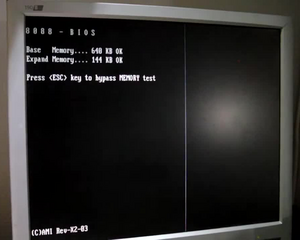
|
Possibly the earliest known version. AMIBIOS 2.03 is an assumed name. |
| AMIBIOS 2.2x(?) | 1986 | 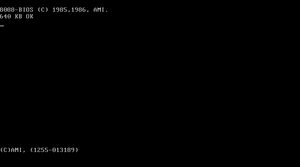
|
The name is assumed based on information from the unofficial MR BIOS website[4] and therefore may not be correct. |
| AMI Plus BIOS(?) | 1987 | 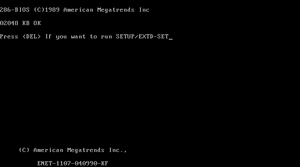
|
The name is assumed based on information from the unofficial MR BIOS website[5] and may not be correct. Unofficially also called the AMI Pre-Color BIOS due to its monochrome setup utility, which came out before the AMI Hi-Flex BIOS with its colorful utility. |
| AMI Hi-Flex BIOS | 1990 | 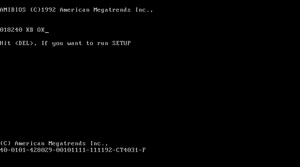
|
Not to be confused with the Hi-Flex Setup Utility on AMIBIOS 6 and 07.00.10, which was named after it. Unofficially also called AMI Color BIOS due to its colorful setup utility. Likely and internally also called AMIBIOS 3, although unconfirmed. |
| AMI WinBIOS (AMIBIOS 4) | 1993 | 
|
Often referred to as the AMI WinBIOS, not to be confused with the WinBIOS Setup Utility on AMIBIOS 6 (which was named after it). |
| AMIBIOS 5 | 1994 | 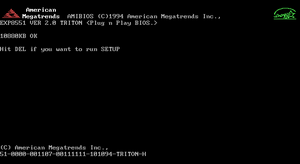
|
Visually almost identical to the AMIBIOS 4, although contains new features and likely also initial bug fixes. |
| AMIBIOS 6 | 1995 | 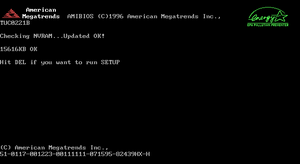
|
|
| AMI eBIOS Version 1 | Unknown | Not available. | Assumed to exist due to the existence of the eBIOS 02.00.xx. |
| AMIBIOS 07.00.xx / 07.00.00 | 1999 | 
|
Known as both AMIBIOS 07.00.xx and 07.00.00. Likely a pre-release version of AMIBIOS 8, although was used on various retail systems in 1999 and the early 2000s. Not to be confused with the AMIBIOS 07.00.10. |
| AMI eBIOS 02.00.xx | 1999 or 2000 | 
|
Assumed to be a variant of AMIBIOS 07.00.xx for embedded systems. |
| AMIBIOS 7 (07.00.10) | 2001 | 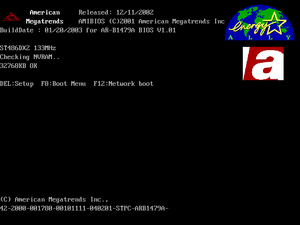
|
Assumed to be an update based on the AMIBIOS 6 codebase. Not to be confused with the AMIBIOS 07.00.xx/07.00.00, which is based on a newer codebase. |
| 64-Bit AMIBIOS Version 1 | 2001(?) | Not available. | Assumed to exist due to the existence of the 64-Bit AMIBIOS 02.00.00. |
| AMIBIOS 8 | 2001 | 
|
Last commercial version of the AMIBIOS. Most likely the final product for AMIBIOS 07.00.xx/07.00.00. Although first released in 2001, it was not widely used until a couple years later. |
| 64-Bit AMIBIOS 02.00.00 | 2003(?) | Not available. | Likely the predecessor for the AMI Aptio, partly based on AMIBIOS 8 or 07.00.xx. Only known instance is on the SuperMicro MBD-i2DML-8G2-O motherboard. |
| AMIBIOS 9 | Unknown | Not available. | Used in Microsoft Hyper-V. Assumed to be the name given to the BIOS component for CSM mode in AMI Aptio. |
BIOS string
The BIOS string was first introduced with AMIBIOS 2.2x for easy identification of each BIOS revision (by the OEM/manufacturer) and is often seen during POST near the very bottom of the screen. The string is formatted to contain various sections, with each containing information for a different field. Known codes for these sections are given in the List of codes for BIOS strings (also available at the bottom of this page section). The formats have been changed various times with some new releases of AMIBIOS.
AMIBIOS 2.2x
MMMM: Manufacturer/OEM identification code, SSSSSS: BIOS version release date
MMMM-SSSSSS
Example string: 1406-061286
This string is for an AMIBIOS 2.2x version (released on June 12, 1986, "061286") for Flying Triumph Co. Ltd. ("1406").
AMI Plus BIOS
D: CMOS setup type, CCC: Chipset type, MMMM: Manufacturer/OEM identification code, SSSSSS: BIOS version release date, KK: Keyboard controller ID (with second character indicating the model).
DCCC-MMMM-SSSSSS-KK
Note: The CMOS setup type code can also be two characters for "DE" in case the BIOS contains both extended setup and built-in diagnostics.
Example string: D286-1277-043089-K0
This string is for an AMI Plus BIOS version (released on April 30, 1986, "043089") with built-in diagnostics ("D") for a machine with a discrete 286 logic ("286") and a default/unknown keyboard controller (K"0") for Trangg Bow Co. ("1277").
AMI Hi-Flex BIOS and later versions
C: Processor architecture, R: ROM size, MMMM: Manufacturer/OEM identification code, FFFFFFFF: BIOS feature identification (often 00101111), SSSSSS: BIOS compile date OR subcore release date, DDDDDDDD: BIOS identifier, Project: internal BIOS project ID (can only be seen on late revisions of AMIBIOS 6 and later), Y2KC: unknown, most likely Year 2000 compatibility indicator (optional, can only be seen on AMIBIOS 07.00.xx and 8), K: Keyboard controller ID (unused on AMIBIOS 07.00.10 and 8)
CR-VVVV-00MMMM-FFFFFFFF-SSSSSS-DDDDDDDD-Project-Y2KC-K
Example string: 61-0530-001169-00101111-071595-440BX/ZX-1AAET006-R
This string is for a 05.30 version ("0530") 128 KB ("1")* size AMIBIOS 6 ("071595", main revision date for it) for 686 architecture processors ("6") with Intel 440BX or ZX chipset ("440BX/ZX") and an AMIKEY '94 clone keyboard controller ("R") for project ID 1AAET006 of MSI ("1169").
*The BIOS ROM size is actually 256 KB in this specific case, the 128 KB size specified in the string is an error. This also means the string is not always fully accurate, although mostly is.
List of known codes for BIOS strings
Click "Expand" to view.
- ↑ https://www.intel.com/content/www/us/en/content-details/630266/removal-of-legacy-boot-support-for-intel-platforms-technical-advisory.html | Note: Although this document was published in 2023, it clearly mentions legacy boot being discontinued in 2020.
- ↑ https://twit.tv/shows/triangulation/episodes/226
- ↑ https://www.youtube.com/watch?v=5jYX3sL08Xs
- ↑ https://mrbios.com/techsupport/award/postcodes.htm | "AMI BIOS 2.2x" section
- ↑ https://mrbios.com/techsupport/award/postcodes.htm | "AMI Plus BIOS" section